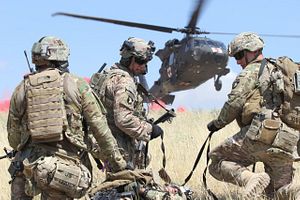The Pentagon announced on September 6 that it will dispatch about 1,400 soldiers of the 101st Airborne Division to Afghanistan in the fall in support of counterterrorism operations in the country. The deployment is part of a regular troop rotation and will not increase overall U.S. troop strength in Afghanistan.
The U.S. Army did not reveal the duration of the deployment of the 3rd Brigade Combat Team (part of the 101st Airborne Division) or the exact mission of the troops, although one can expect that the unit will have a general “train, advise, assist” mission focus. A prepared U.S. Army statement mentions that the troops are being sent to the country in support of Operation Freedom’s Sentinel—the United States’ counterterrorism mission in Afghanistan. This mission includes conducting unilateral U.S. operations against al-Qaeda and the Islamic State group as well as training and mentoring the Afghan National Defense and Security Forces (ANDSF).
“From hunting al-Qaeda and Taliban forces during Operation Anaconda in 2002, to performing the advise-assist mission in 2014-15, the soldiers of the 3rd Brigade Combat Team have been nothing short of exceptional while supporting operations in Afghanistan over the years,” said Brigadier General Scott E. Brower, the acting senior commander of the 101st Airborne Division. “The Rakkasans [the brigades nickname] are trained, well-led, and prepared to accomplish any mission given to them while supporting Operation Freedom’s Sentinel.”
The unit will deploy under the command of the 101st Airborne commanding officer, Major General Gary Volesky. This will be the fifth deployment of the 3rd Brigade Combat Team to Afghanistan. The last deployment of the 3rd brigade to Afghanistan came to an end in October 2015, where it was deployed to the eastern part of the country and focused on training the Afghan National Army’s 201st and 203rd Corps.
The U.S. State Department has also recently approved a possible $60 million sale of military equipment including rifles, machine guns, and grenade launchers to Afghanistan under the Pentagon’s Foreign Military Sales program amid rising civilian and military casualties in the country. As I explained elsewhere:
6,637 ANDSF personnel were killed and 12,471 wounded in 2015. The number killed is about 20 percent higher in 2016 in comparison to the previous year, the top U.S. commander in Afghanistan, General John Nicholson, announced in late July without providing specific numbers. Over 1,600 Afghan civilians were killed and 3,565 injured in the first half of 2016, which marks “an overall increase of four per cent in total civilian casualties compared to the same period last year,” according to a United Nations report published in July.
As The Diplomat reported previously, on August 25, the Pentagon announced that it had sent around “about 100 troops, an expeditionary advisory package, in total” to Lashkar Gah, the capital city of Afghanistan’s embattled Helmand province to prevent the provincial capital from falling into the hands of the Taliban.
According to the Pentagon press secretary Peter Cook the soldiers’ mission will consist of two parts: “[F]irst to provide training, advice, and assist to the police zone headquarters there in Lashkar Gah, and second to provide force protection for those actually doing the advising. So some of these forces are there to protect those forces, and they were all done under the Resolute Support mission.”
Over the past 14 years, more than $68 billion have been appropriated by the United States Congress to train, equip, and pay the salaries of up to 352,000 soldiers and police in in the ANSDF, as well as 30,000 members of the Afghan Local Police (ALP).

































